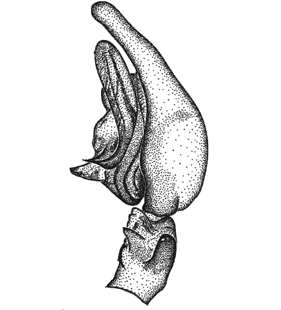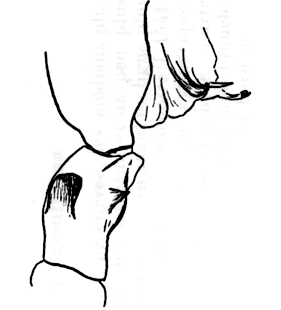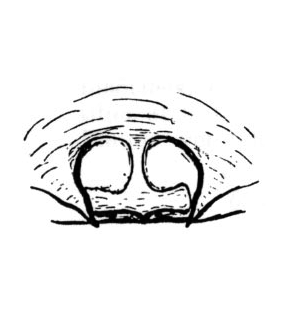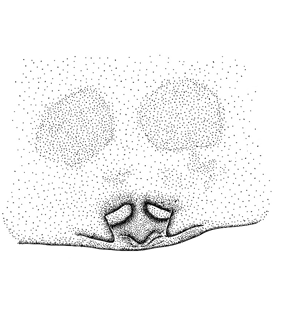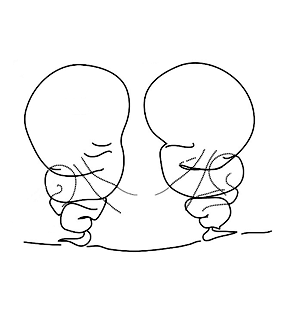Aterigena ligurica (Simon, 1916)
Description
Male
RTA with a large dorsal branch, distally pointed and strongly sclerotized; lateral branch forming sclerotized finger-shaped appendix; ventrally bearing a weakly developed rounded ridge. Embolus originating (free apex) at 7 o’clock position; length (only the free apex) slightly more than twice cymbium width; distal tip between 3 and 4 o’clock position. Conductor lamella-like, distally elongated (parallel to cymbium), arcuated and laterally folded along the whole length; as long as alveolus, distally reaching beyond alveolus margin; terminal end forming sclerotized peak, pointing ventrally (in lateral view). Connection of conductor and tegulum membranous. Median apophysis consisting of membranous base and thin and broad sclerotized distal plate, pocket-like; originating at 5 o’clock position; protruding ventrally; basis as wide as median apophysis length. Tegular apophysis absent. Prosoma length: 6.82 mm.
Female
Epigynal plate strongly sclerotized, trapezoidal, with distinct atrium; atrium posteriorly reaching epigastral furrow. Ground plate of atrium strongly sclerotized, anterior distinctly connected with epigynal plate, undivided reversed trapezoidal shaped. Lateral margins of atrium converging posteriad, strongly elongated vertices present. Receptacula visible through plate. Copulatory openings well-visible as holes, located at anterior border of atrium. Copulatory duct short and straight. Receptacula large, oval to globular, almost touching each other; fertilization ducts long and strongly convoluted. Prosoma length: 5.63–6.58 mm.
Additional information
Eyes: In dorsal view both eyerows straight or slightly recurved; in frontal view PER procurved and AER straight or slightly procurved. Diameters: PME: 0.21–0.23; PLE: 0.20–0.24; AME: 0.18–0.21; ALE: 0.21–0.24. Distances: PME–PME less or equal diameter of PME; PME–AME less than diameter of PME; PME–PLE about diameter of PME; PME–ALE about diameter of PME or slightly more; AME–AME 0.5–1.0 times diameter of AME; AME–ALE about half diameter of AME. Clypeus height (measured under AME) less than or equal to 3 times diameter of AME; (measured under ALE) about twice diameter of ALE or slightly more. Coloration: Carapace with narrow, continuous dark margin; two longitudinal symmetrical darkened bands present on carapace, interrupted and sometimes reduced to triangular dots. Sternum with brighter median band, sometimes very weak. Opisthosoma with red-brown median band, anterolaterally with two bright bands, continuing posteriorly as dots. Legs weakly annulated best expressed ventrally on femora. Additional somatic characters: Distal margin of labium weakly concave. Plumose hairs present on carapace, legs and opisthosoma. Four promarginal teeth, the second one from proximal largest; 4–5 retromarginal teeth, most proximal tooth largest. Trochanter III and IV notched. Tarsi I and II with 7–8 dorsal trichobothria and 8–9 on tarsi III and IV. Colulus forming rectangular plate, distal margin straight, only partly colored. PLS longer than all others with distal segment as long as or slightly longer than basal segment, both darkened. PMS as long as ALS. ALS slightly darkened.
Distribution
Phenology
| Jan | Feb | Mar | Apr | May | Jun | Jul | Aug | Sep | Oct | Nov | Dec |
 |  |
Figures
Distribution List
"No references" does not mean that the species does not occur in this country, but that we have not yet inserted the reference for it. We are working on it.
References
Bolzern A, Hänggi A, Burckhardt D (2010) Aterigena, a new genus of funnel-web spider, shedding some light on the Tegenaria-Malthonica problem (Araneae: Agelenidae) Journal of Arachnology 38: 162-182 ![]()
Branco V V, Morano E, Cardoso P (2019) An update to the Iberian spider checklist (Araneae). Zootaxa 4614: 201-254 ![]()
Dresco E, Célérier M-L (1976a) Étude des tégénaires. Tegenaria ligurica Simon 1916 (Araneae, Agelenidae). Annales de Spéléologie 31: 219-221 ![]()
Maurer R, Thaler K (1988) Über bemerkenswerte Spinnen des Parc National du Mercantour (F) und seiner Umgebung (Arachnida: Araneae). Revue Suisse de Zoologie 95: 329-352 ![]()
Pantini P, Isaia M (2019) Araneae.it: the online catalog of Italian spiders, with addenda on other arachnid orders occurring in Italy (Arachnida: Araneae, Opiliones, Palpigradi, Pseudoscorpionida, Scorpiones, Solifugae). Fragmenta Entomologica 51: 127-152 ![]()
Simon E (1937) Les arachnides de France 6 (5). Paris (Roret): 979-1298 ![]()
WSC (2024) World Spider Catalog. Version 25.5. Natural History Museum Bern, online at http://wsc.nmbe.ch (31.10.2024) doi: 10.24436/2 ![]()



